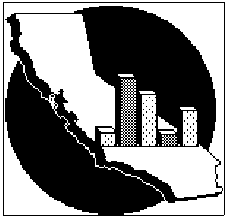
The plan adopted last July to pay off the 1993-94 budget deficit over a two-year period and achieve a balanced budget by the end of 1995-96 is now out of balance, by about $2 billion. The Governor proposes to eliminate the budget gap and end 1995-96 with a small surplus by taking several steps. These include $1.4 billion of program reductions (primarily welfare grant reductions) and other savings, and shifting $0.9 billion of costs to the federal government and localities (through a state/county restructuring proposal). The Governor's budget plan also proposes a phased-in 15 percent reduction in income tax rates, in combination with leaving high-income tax brackets in place that are scheduled to expire in 1996. The budget's estimated net revenue loss from this tax proposal is $225 million in 1995-96 and a cumulative $7.6 billion over four years.
Because the budget proposal does not include a meaningful reserve, it could easily be thrown out of balance by any significant increase in costs or shortfall in revenue. We have identified a number of major budget risks, totaling several billion dollars, that could jeopardize achieving a balanced budget in 1995-96. These risks include pending budget-related litigation and reliance on future federal actions.
Although California's economy is growing once more, and the budget situation has improved, the long-term outlook indicates that if the Legislature chooses to fund the Governor's spending priorities for education and corrections and adopt his tax cut proposal, substantial ongoing reductions will be necessary elsewhere in the budget. The Governor has proposed major reductions in welfare and health programs that (in combination with his other proposals) could yield sufficient savings to finance his budget plan through the end of the decade. However, our projections indicate that the budget situation is likely to remain precarious throughout this period, even with the magnitude of savings proposed by the Governor. Consequently, it appears unlikely that the state would have sufficient funds to create a meaningful reserve or to expand, restore or create new programs without making corresponding reductions elsewhere in the budget. Furthermore, the budget would remain highly vulnerable to risks and contingencies.
In this part we assess the state's current fiscal condition and outlook, and analyze the Governor's proposals to address the budget gap for 1995-96. We also examine the implications of the Governor's proposals over the next few years.
The 1994-95 budget plan adopted last July was intended to pay off prior-year deficits over a two- year period and achieve a balanced budget in 1995-96. That two-year plan has fallen out of balance, requiring significant budgetary adjustments to be made in order to achieve a balanced budget by the end of 1995-96.
The state's economic performance during 1994 is not to blame for the deterioration of the July budget plan. In fact, the state is experiencing a modest revenue increase due to improved economic growth, and caseload growth is moderating as well. Rather, the current budget problem reflects the large gap between the July plan's assumption that the state would receive $3.6 billion of federal funds for immigrant costs through 1995-96, and actual federal appropriations and authorizations to date, which will provide only about $300 million.
The nation's economy experienced the best of both worlds in 1994-- reasonably good growth with relatively modest inflation. Real Gross Domestic Product (GDP) rose by about 4 percent, and inflation was 3 percent. Labor markets reflected the strength in the economy, as the unemployment rate dropped to around 6 percent.
The Department of Finance (DOF) expects economic growth to slow to 2.5 percent in 1995 and 2.2 percent in 1996, with inflation in the mid-3-percent range in both years. Other elements of the forecast are for a slowing housing market, continuing gains in business investment, and ongoing strength in foreign trade. The DOF forecast is in general agreement with the consensus of other forecasters, although it is somewhat weaker for 1995 and stronger for 1996.
California's Economy Is Clearly Recovering. California's economy is strongly influenced by national economic performance. However, its unique characteristics also mean that its performance can differ significantly from the nation's. The state's recession was worse and its recovery has been slower than the nation's. For example, California experienced relatively sluggish economic performance through the early part of 1994, and has not yet regained its prerecession employment level, as has the nation. A variety of indicators suggest, however, that the state's economy is now on a sustained recovery path.
The DOF projects that state personal income will increase by 6.6 percent in 1995 and 6 percent in 1996. Employment growth is expected to be in the range of 2 percent to 3 percent annually, and moderate growth is predicted for corporate profits and taxable sales. The department's forecast of ongoing expansion is shared by us and by other forecasters as well.
Even though continued expansion is expected, the strength of the state's economy will be limited by continued cutbacks in defense spending, military base closures, and industry restructuring. It also will depend on the strength of the export market and whether further interest rate increases occur, which could depress the recovering housing market.
Employment Still Below Prior Peak. California employment is projected to finally get back to its prerecession level in the last half of 1996. Employment began declining in early 1990 and hit a low point in the first quarter of 1993. Job losses totaled nearly 700,000 during this period. Since then, employment has increased steadily, having risen by about 240,000.
Budget Based on Moderate Underlying Revenue Growth. Based on the budget's revenue estimates (in the absence of new policy proposals), underlying budget-year General Fund revenue growth is $1.4 billion, or 3.4 percent. Revenue growth is even somewhat higher if adjustments are made for a variety of special factors, such as the phasing-in of various previously enacted legislation. Overall, the budget estimates that the pace of underlying revenue growth will be moderate.
Despite the improvement in the state's economic and revenue outlook, the two-year budget plan adopted in July has fallen out of balance. This is because the budget's assumption of $3.6 billion of additional federal funding for immigrant costs far exceeds federal action to date. Figure 1 shows the changes to the July 1994 budget estimates for 1994-95 and 1995-96, based on the January 1995 estimates in the 1995-96 Governor's Budget, adjusted to exclude new revenue and spending proposals in the budget. Thus, the changes shown in the figure reflect our estimate of baseline revenues and spending using the administration's latest revenue forecast and caseload projections. The federal funds shortfalls shown in the figure reflect the difference between the July budget estimates and our current estimate of California's share of federal appropriations and authorizations that have actually been approved by Congress to date.
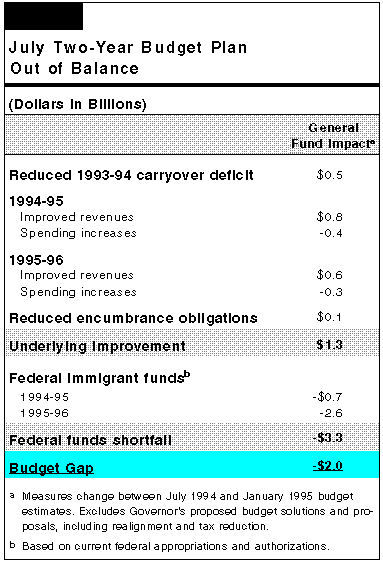
The budget plan adopted in July sought to eliminate an estimated $2 billion 1993-94 year-end budget deficit by the end of 1995-96, when the General Fund would achieve budgetary balance (with a minimal reserve of $29 million). As Figure 1 shows, however, absent corrective action, the state's General Fund now faces a $2 billion budget gap in 1995-96. The budget gap represents the minimum amount of savings and/or revenue from changes to existing laws and policies that is needed in order to achieve a balanced budget in 1995-96. As such, it is a useful measuring stick for budget-balancing actions and provides a basis for comparing different approaches to resolving the budget problem.
Based on the budget changes identified in Figure 1, the General Fund will end 1994-95 with a deficit of $740 million (which is less than the $1.0 billion year-end deficit projected in July). However, the shortfall in federal immigrant funds results in an operating shortfall of $1.2 billion between baseline spending and estimated revenues in 1995-96. The combined effect of the carryover deficit from 1994-95 and the 1995-96 baseline operating shortfall results in a 1995-96 year-end budget deficit of $2 billion if no corrective action is taken, as shown in Figure 2. While the state's underlying revenue and expenditure trends have improved by $1.3 billion, commitments of federal immigrant funds fall $3.3 billion short of the July assumptions.
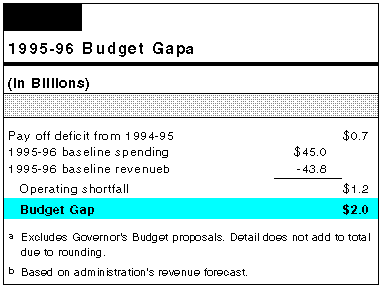
In contrast with recent years, changes in the state's underlying revenue and spending trends (excluding federal immigrant funding) have been positive since enactment of the budget. Budget estimates indicate that underlying revenues and expenditures both have grown, but that the revenue increase is twice as much as the spending increase.
Revenues Are Up. Estimated General Fund revenues show improvement over the two-year period, reflecting the strengthened economic outlook. Compared with the July budget estimates, revenues (before the proposed tax reduction) increase by a total of $1.4 billion--$817 million in 1994-95 and $583 million in 1995-96. Improved revenue collections in the final months of 1993-94 also account for most of the $500 million reduction in the deficit carried over from 1993-94.
Revenue Gains Increase Proposition 98 Spending. Projected spending increases in 1994-95 and 1995-96 offset half of the revenue gain in each year. These spending increases primarily reflect the effect of the additional revenues in increasing the state's funding obligation to schools and community colleges under Proposition 98. Other spending changes are roughly offsetting.
Of the total of $3.6 billion of new federal funds for the costs of illegal immigrants and refugees assumed in the July budget plan, we estimate that Congressional actions to date will provide about $300 million--all for incarceration costs of felons who are illegal immigrants. California will receive about $78 million over the two years from a current federal budget appropriation. The federal crime bill also authorizes an additional $300 million appropriation nationwide for the federal 1996 budget, of which California's share could be about $200 million.
To date, however, Congress has not provided any of the new funding assumed in the July budget plan for education and health care costs of illegal immigrants or for refugee costs. Thus, there is a $3.3 billion federal funds shortfall in the two-year budget plan.
Figure 3 shows the Governor's proposed amounts of revenues and spending for 1994-95 and 1995-96 and the resulting General Fund condition (consistent with traditional state accounting practices). Proposed revenues and spending in 1995-96 are almost unchanged from the estimated 1994-95 amounts. This lack of growth, however, reflects the effect of the Governor's realignment proposal, which shifts $1 billion of state revenues and expenditures to counties and off of the General Fund budget. (The proposal also includes a $600 million spending shift within the budget.) Figure 3 also shows the percentage growth in spending and revenues adjusted to include these shifted amounts in order to place figures for 1994-95 and 1995-96 on a comparable basis.
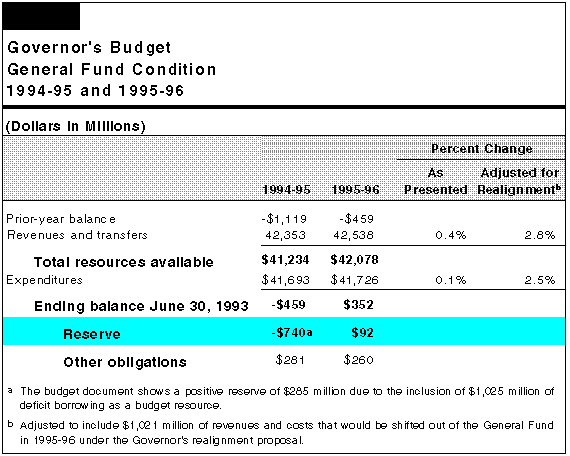
Adjusted for realignment, proposed General Fund revenues and spending both increase modestly in 1995-96, with revenues growing slightly faster than spending--2.8 percent revenue growth versus 2.5 percent spending growth. For comparison, our estimate of baseline spending grows by 8 percent from 1994-95 to 1995-96. The budget projects a small reserve of $92 million at the end of 1995-96. Thus, the administration still proposes to achieve the goal of the July two-year plan--eliminating the 1993-94 carryover deficit by the end of 1995-96.
Figure 4 shows how the budget proposes to address the $2 billion budget gap noted above and allow for the $92 million reserve.
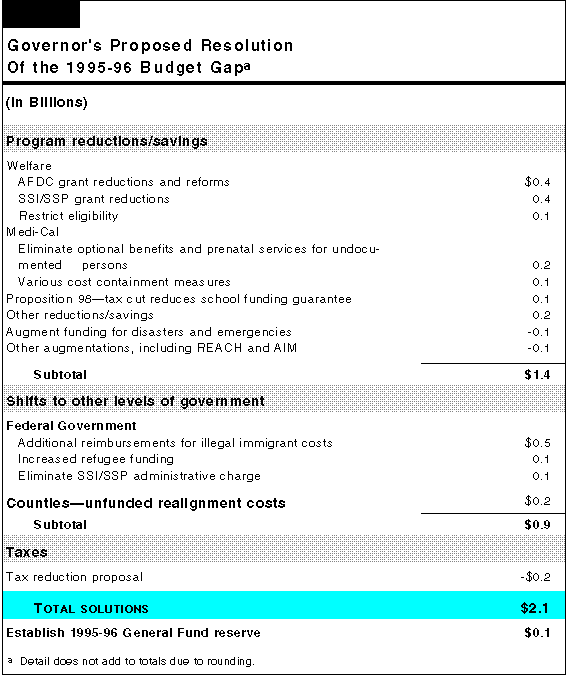
Spending. As shown in the figure, program reductions and savings fill most of the budget gap ($1.4 billion). The bulk of the proposed reductions are in health and welfare programs, and they generally reflect a continuation of proposals that the Governor made last year. The largest amounts of savings come from proposed welfare grant reductions and restrictions in the AFDC and SSI/SSP programs. Federal Funds and Realignment. The budget continues to rely on additional federal funding to offset the state costs of providing services to illegal immigrants and to refugees. However, the amount of new federal funds is much less than the $2.8 billion assumed in the July budget estimate for 1995-96 (see below). The budget also includes a net state savings of $241 million from the state/county realignment plan. Resources provided to counties would fall short of costs shifted to them by this amount, which the budget proposes to offset with county savings from proposed mandate relief legislation.
Revenues. Budgeted revenues reflect a proposed reduction of $225 million in 1995-96 due to the first year of a phased three-year reduction in personal and corporate income taxes. (This tax proposal is discussed in detail in Part Five of this volume.) Approximately half of this revenue loss is offset by a reduction in education funding due to the resulting reduction in the Proposition 98 minimum funding guarantee.
The budget proposes a significant shift of responsibility and funding from the state to the counties for certain welfare and social services programs. As detailed in Figure 5, the proposal shifts about $1.9 billion of state costs to the counties, along with $1.6 billion of state resources (a combination of state sales tax revenue, fine revenue, and increased state funding for local trial courts). The state would realize a net savings (and the counties a cost) of $241 million in 1995-96 under the proposal. The current realignment proposal contains some of the same elements included in the more extensive restructuring proposal presented in the 1994-95 Governor's Budget. (We discuss the realignment proposal in more detail in Part Five of this volume.)

In order to achieve $1.5 billion of the new savings proposals in the budget, the state needs various federal actions to provide new funds or to change laws or waive existing program requirements. Figure 6 lists these budget proposals and categorizes them.

As shown in the figure, the budget assumes savings of almost $590 million in 1995-96 from additional federal funds to offset the state costs of health and welfare services to illegal immigrants and to refugees. This amount is in addition to $245 million for incarceration costs that we estimate is the state's share from existing federal appropriations or authorizations. The January budget proposal, however, does not include $1.7 billion of federal reimbursements in 1995-96 assumed in the July budget plan for the education costs of illegal immigrant children. Figure 6 also shows that a total of $880 million of new savings proposals in 1995-96 depend on the enactment of federal legislation or the approval of administrative waivers.
Welfare Proposals. The budget proposes legislation to enact various AFDC grant reductions and welfare reforms similar to proposals that the administration has put forward in previous budgets. These actions include a 7.7 percent grant reduction effective September 1, 1995, an additional 15 percent grant reduction after six months on aid, and a two-year time limit for aid to able-bodied adults. The budget estimates $254 million in General Fund savings from these actions in 1995-96. The budget also proposes SSI/SSP grant reductions of 8 percent for individuals and 10 percent for couples, for a General Fund savings of $434 million in 1995-96.
Medi-Cal Optional Benefits. The budget again proposes to eliminate certain optional benefits that California provides under the Medi-Cal program. The benefits that would be eliminated include adult dental care, psychology, and podiatry--for a net General Fund savings of $143 million in 1995-96.
Prenatal Services. The budget proposes to eliminate funding for a state-only program of prenatal services to undocumented immigrant women. This would reduce General Fund spending by $79 million in 1995-96. Undocumented women would remain eligible for federally required emergency and obstetric services under Medi-Cal.
Full Funding for Corrections. The budget proposes $3.5 billion ($3.3 billion from the General Fund) for support of the Department of Corrections (CDC). The budget proposal represents an increase of $374 million, or 13 percent, above estimated General Fund expenditures in the current year. The proposed increase will essentially provide full funding for workload growth in the department and provide augmentations for several policy changes. Proposition 98. The budget proposes an additional $1.2 billion in Proposition 98 funding for K-12 and community colleges in 1995-96 due to General Fund revenue growth and a large anticipated increase in the K-12 student population. Consistent with existing law, the budget proposes to deduct a total of $514 million (1994-95 and 1995-96 combined) from the amount of funds distributed to school districts. These amounts would be set aside for making partial repayments of past Proposition 98 loans.
The additional funding has the result of increasing average per-student support for K-12 to $4,292, an increase of $61, or 1.4 percent over the current-year level. The budget proposes a 2.2 percent cost- of-living adjustment, at a cost of $444 million, in K-12 general-purpose and special education spending, and $55.2 million for community colleges. No cost-of-living adjustment is proposed for K-12 categorical programs.
Higher Education. The budget treats both the University of California (UC) and the California State University (CSU) similarly after adjusting for one-time expenditures at CSU. For each segment, the budget provides 2 percent increases for unspecified general purposes, and funds increases in debt-service costs for lease-payment bonds. The budget proposes a four-year compact with UC and CSU which includes a commitment to provide General Fund increases averaging 4 percent for the three fiscal years beginning in 1996-97. Among other things, the plan also calls for enrollment growth averaging about 1 percent annually, increases in faculty salaries, productivity improvements, and reductions in students' time to obtain an undergraduate degree.
Department of Transportation Staff Reduction. The budget proposes to reduce the staffing level of Caltrans by over 1,200 personnel-years. This reduction is primarily due to a funding shortfall resulting from failure of various transportation bond measures. About one-third of these reductions are proposed in departmental administration and in highway project design and engineering.
The Governor has adopted the recommendation of his Task Force on Tax Reform and Reduction that the state's income tax rates be reduced. The Task Force's view is that California's tax rates are too high, and that reducing them will stimulate economic activity, including attracting more businesses to California.
The tax proposal has two parts:
In 1990-91 and 1991-92, the state incurred large budget deficits as the recession proved unexpectedly deep and prolonged. Since then, according to the budget, the state has been living within its means, in that General Fund revenues have equaled or exceeded General Fund spending each year. The state's ongoing budget problems, according to this view, result from the pre-1992-93 deficits and not from further imbalances since then.
Figure 7 shows General Fund operating balances for the current year and for the past two years. The operating balance compares current revenues with current spending in any year. As illustrated in the figure, the budget indicates that the General Fund has operating surpluses of $660 million in the current year and $1.1 billion in 1993-94, and that the operating budget was essentially balanced in 1992-93. However, during this three-year period, more than $2 billion of spending was placed off budget or deferred to future years or was offset by a one-time accounting gain. Specifically, the budget spending figures benefitted from the following adjustments:
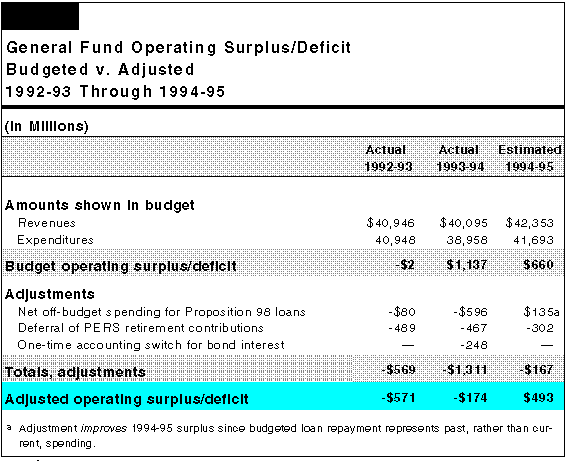
Figure 7 shows that if these paper savings are excluded, then the General Fund incurred operating deficits in 1992-93 and 1993-94 and that the estimated current-year operating surplus is reduced to $493 million.
In addition to the adjustments shown in Figure 7, the General Fund currently has obligations totaling almost $800 million in outstanding loans from special funds and deferred costs to meet various commitments set out in existing law. These loans and spending deferrals also have helped to improve the budget's operating balance on a temporary basis. These obligations fall into the following categories (amounts shown are approximate):
Because the projected budget reserve at the end of 1995-96 is only $92 million, any significant added spending or loss of revenue would throw the budget out of balance. Consequently, it is important to assess the major budget risks that could affect the state by the end of 1995-96.
Figure 8 summarizes some of the major budget risks that could jeopardize achieving a balanced budget in 1995-96. The amounts shown represent the budget's maximum likely exposure. As the figure shows, the state faces budget risks totaling billions of dollars in 1995-96. While it is unlikely that all of these risks will be realized, and any actual budget impacts may be less than shown in the figure, clearly the magnitude of these risks poses a significant threat to the budget.
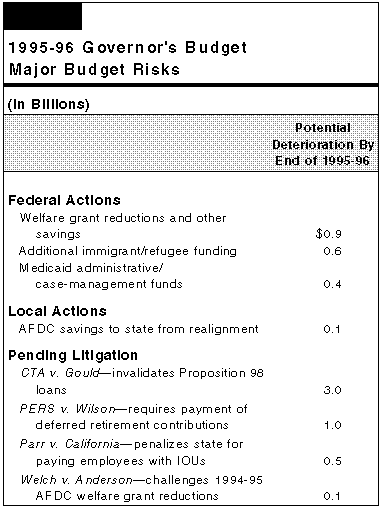
Approximately $1.9 billion of budget savings depend on federal actions assumed in the budget agreement, either to provide additional funds or to allow program revisions. This amount includes $400 million of Medi-Cal administrative/case-management funds assumed in the 1994-95 budget, but not yet approved by the federal government. The budget also depends on counties improving their AFDC administration to reduce state costs.
Pending litigation poses budget threats totaling billions of dollars. There have been initial trial court decisions adverse to the state in all of the cases cited in the figure, although they are subject to appeal and the actual fiscal impacts are still uncertain. Perhaps the most significant case is CTA v. Gould, which poses a $3 billion budget risk by invalidating certain Proposition 98 loans provided to schools and community colleges by the state. The decision would increase the carryover deficit by $1.8 billion to recognize spending for past off-budget loans, and it also could increase spending through 1995-96 by $1.2 billion by raising the base funding level for Proposition 98. Two other cases pose large risks. In PERS v. Wilson, the court determined that the state's deferral of its employee retirement contributions was unconstitutional and ordered the state to pay about $1 billion in deferred contributions and earnings. In Parr v. California, a federal court has found that the state violated the federal Fair Labor Standard Act by paying employees with registered warrants while the budget was delayed in 1992-93, and has ordered a proceeding to determine the damages and penalties against the state. These could range up to $500 million.
In addition to the litigation listed in Figure 8, cases that still are at the trial court level could impose substantial costs on the state. For example, Orthopedic Hospital v. Kizer is a pending suit that challenges Medi-Cal outpatient rates and seeks to increase them. Another case--American Lung Association of California v. Wilson�challenges the state's use of Proposition 99 cigarette tax funds to support certain programs. An adverse decision could result in pressure on the General Fund to replace Proposition 99 support for these programs. A decision appears imminent. Furthermore, several suits have been filed challenging past use of special fund money to help balance the budget. The Governor's Budget proposes to use an additional $49 million of special fund money (from the Employment Training Fund and the Beverage Container Recycling Fund) to support General Fund programs in 1995-96.
The �trigger� legislation enacted as part of the 1994-95 budget plan prohibits the 1995-96 budget from ending the year with a cash shortfall, as defined. Based on the two-year budget plan adopted in July 1994, a cash �cushion� of $1.3 billion was estimated. The 1995-96 budget now estimates a cash cushion of about $1 billion. Given the magnitude of the risks discussed above, this cushion does not provide a large margin for error. The actual determination of whether the trigger is pulled will be made by the State Controller in October 1995 with input and review by the Legislative Analyst's Office. That determination will depend primarily on the budget that is adopted and fiscal developments during the early part of the budget year.
Given the Governor's tax proposal and the tight budgets of recent years, it is important to know the implications of the Governor's budget proposals for the future. One natural question is what levels of funding for state programs would be possible, based on the revenues that would be available if the tax proposal is enacted. The budget estimates that, assuming current tax laws, the state can expect to receive $28 billion in cumulative revenues from 1995-96 through 1998-99 beyond what would be received if revenues experienced no growth from their 1993-94 level. The budget projects, assuming adoption of the budget proposals, that the distribution of this added revenue would be $7.6 billion to pay for the tax cut, $11.9 billion for Proposition 98 education funding, $2 billion for debt and the remaining $6.5 billion for �discretionary� spending. (A more recent analysis of the tax cut proposal by the Franchise Tax Board estimates a slightly lower four-year cost of $7.3 billion.) The budget includes within this �discretionary� spending category such items as the homeowners' exemption (which is provided for constitutionally), debt service on lease-payment bonds, and interest costs on short-term cash borrowing. It also includes all remaining programs in the budget, including corrections, health and social services, and higher education.
Our estimates indicate that, assuming a moderate economic and revenue growth scenario with no recessions or significant economic slowdowns, the state can expect to receive about $24 billion in cumulative additional resources between 1995-96 and 1998-99 compared to the administration's $28 billion figure. Our figure differs from the administration's primarily because we are looking at the additional resources that would be available compared with a situation in which revenues experienced no growth from their current 1994-95 level. We also have different assumptions pertaining to the pace of revenue growth and certain other factors.
Figure 9 shows that the distribution of these revenues would be $7.6 billion for the tax cut, $8.6 billion for Proposition 98, $2.4 billion for debt service and employee retirement, and $5.4 billion for all other programs. This means that spending growth for all of these other programs could increase at an average annual rate of 3 percent.
Given other commitments, however, the spending situation is actually much tighter. For example, the Governor has been committed to full funding of corrections�which, if continued, would absorb $3.9 billion in increased revenues over the four-year period. In addition, the Governor has called for specific levels of funding for UC and CSU�which would absorb about $1.1 billion over the four years. Thus, these two commitments alone would absorb virtually all the remaining resources available over the period. This would leave almost no room for growth in the total amount of funding in the remaining approximately 40 percent of the General Fund budget: primarily health, social services and general government spending.
Creating Reserve Would Further Reduce Spending Room. The above analysis probably overstates the actual level of resources available for other programs. For instance, there is no provision for a budget reserve. Normally, after several years of economic growth, the state would expect to have established at least a modest reserve. A 3 percent reserve would absorb about $1.5 billion.
Additional Spending Pressures. The analysis above implicitly assumes that the state will win on appeal several costly outstanding lawsuits. As noted earlier, the state's fiscal exposure in these cases is in the billions of dollars. Finally, the analysis does not directly take into account the impact of certain provisions of law that are set to go back into effect in the near future. For instance, the renters' credit is scheduled to go back into effect in 1996, resulting in cumulative costs over the remainder of the period of about $1.5 billion. Unless the credit were postponed again or repealed, these costs would have to be absorbed within available resources.
Clearly, the tax cut and spending scenario described above would require some major spending reductions compared with current trends, especially for health and social services programs, which comprise more than 75 percent of the �other programs� portion of the budget. Spending on health and social services programs has increased by an annual average rate of about 8 percent over the last ten years. Even a 5 percent annual growth rate would require a cumulative total of about $7 billion of additional General Fund spending on health and social services programs through 1998-99. The Governor's 1995-96 budget proposal, however, includes significant welfare grant reductions and other savings proposals that would reduce spending on an ongoing basis. We have projected these savings into future years in order to determine how they would affect funding available for the remaining �discretionary� programs in the scenario through 1998-99.
Using the budget's assumptions and implementation schedule, our projections indicate that the Governor's savings proposals could generate several billion dollars of savings through 1998-99�potentially enough savings to provide for increases to offset inflation and population growth in the remainder of the �discretionary� portion of the budget. However, if such increases were provided, this scenario does not leave any significant room to establish a reserve, create or expand programs, or restore programs (such as the renters' credit) without making offsetting savings elsewhere. Furthermore, as discussed above, this scenario presumes that all of the actions assumed in the Governor's budget proposal occur on a timely basis, including federal funding and law changes. These assumptions appear optimistic given the magnitude of the proposed changes.
Although the California economy is again experiencing moderate growth, and the budget is on firmer ground than previously, the long term outlook indicates that funding the Governor's spending priorities and his tax cut proposal will require substantial and ongoing reductions elsewhere in the budget. The Governor has proposed major reductions in welfare and health programs that (in combination with his other budget solutions), could yield sufficient savings to finance his budget plan through the end of the decade. However, our projections indicate that the budget situation is likely to remain precarious throughout this period, even with the magnitude of savings proposed by the Governor. Consequently, our long-term projections suggest that the state would continue to face tight budgets under the Governor's proposals and that the budget would be highly vulnerable to the risks that we have identified and to contingencies that could generate costs or revenue losses.